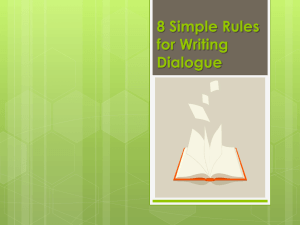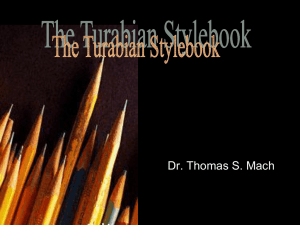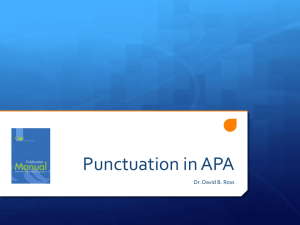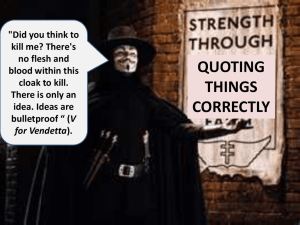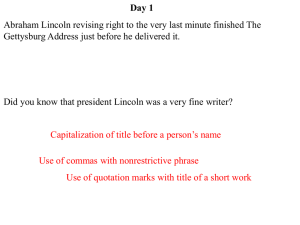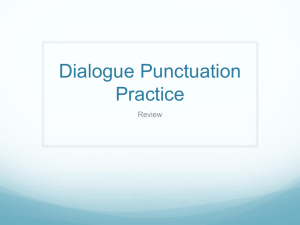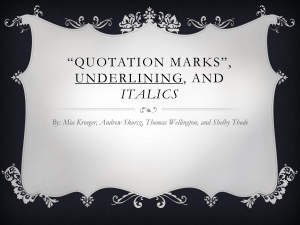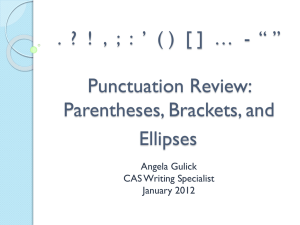Quotation Marks
advertisement
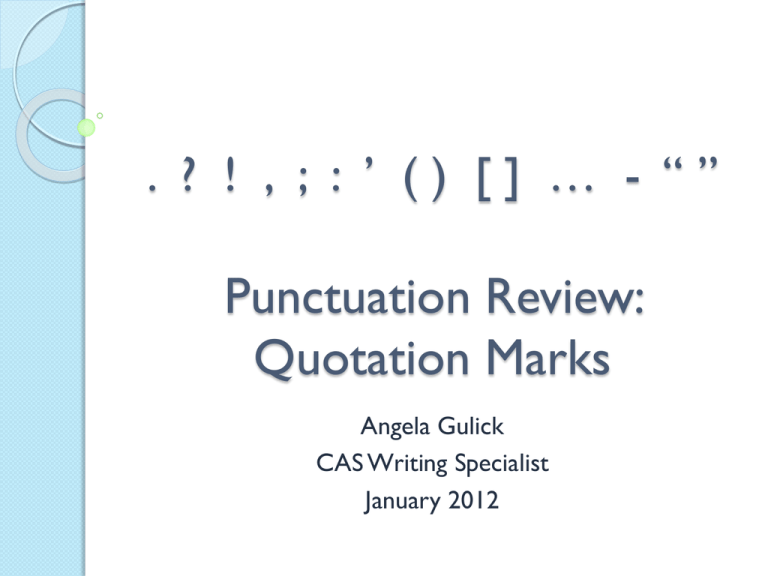
. ? ! , ; : ’ () [] … - “” Punctuation Review: Quotation Marks Angela Gulick CAS Writing Specialist January 2012 Introduction . ? ! , ; : ’ () [] … - “” This workshop provides a general overview that readers can go through at their own pace. The workshop does not cover every detail but focuses on the general rules associated with grammar, punctuation, and mechanics issues. A list of all Writing Lab handouts, PowerPoint workshops, and videos is available on the Center for Academic Success Resources page. A list of online exercises and additional sources is available at the end of this presentation. Copyright Angela Gulick, January 2012 “” Quotation Marks “” “” “” “” “” Double quotation marks have three major functions: “” Use 1: Use quotation marks to highlight words in your own writing to indicate irony or sarcasm. For any Austin Powers fans, these are what I call “Dr. Evil Air Quote” quotations. Here is an example: I told my mother that it would really be “fun” to spend Christmas with her awful aunt Edna. >>> In this example, the word “fun” is not being said seriously; the writer, in fact, means the exact opposite. >>> You should avoid this use of quotation marks in academic writing because it can be unclear if someone else is being quoted or if the you are being sarcastic or ironic. Copyright Angela Gulick, January 2012 “” Quotation Marks “” “” “” “” “” “” Use 2: Use quotation marks around the titles of minor works (shorter segments from larger works). Examples of minor works include the titles of songs, articles in magazines and newspapers, short stories, chapters from books, website articles, and specific episodes of radio and television programs. >>>Grandpa Ferguson's favorite song is “Lydia, The Tattooed Lady.” On the other hand, use italics or underlining for major works (the names of the entire sources). Examples of major works include the title of movies, books, plays, websites, journals, magazines, newspapers, CDs, DVDs, and television shows. >>> I was broken-hearted to learn that Arrested Development was cancelled. If I were Lydia or Lydia’s boyfriend, I think I would demand my money back Copyright Angela Gulick, January 2012 “” Quotation Marks “” “” “” “” “” “” Use 3: Use quotation marks around the exact words either stated or written by another source. It is critical than anything appearing inside of “quotation marks” an exact duplication of the original source. Presenting information within quotations marks that wasn’t part of the original quotation is extremely unethical. There are four main ways to introduce a direct quotation, and these ways will be explored on the next slides. Copyright Angela Gulick, January 2012 Quotation Marks “Introduce ” “a quotation ” “ ”by using “ ”the author's “ ” or “speaker’s ” “” name and an action verb. Here are some sample action verbs: suggests, writes, states, says, comments, insists, questions, argues, claims, etc. Regarding the television program Project Runway, Harold Jorgensen writes, “The one word that was completely overused by the end of the season was fierce.” Katherine declared, “For the final time, I did not put a pancake on that bunny’s head!” >>>Note the punctuation here. Because the quotations themselves are complete sentences and are preceded by action verbs, you need commas before the quotations, and you need to capitalize the first words of the quotations. Copyright Angela Gulick, January 2012 “” Quotation Marks “” “” “” “” “” “” Introduce a quotation by using the word “that.” If you put “that” in front of your quotation, omit the comma and lowercase the first word of the quotation (unless that word is a proper noun that is always capitalized). Note the difference between these examples: “No That” example: Regarding the TV program Project Runway, Harold Jorgensen writes, “The one word that was completely overused by the end of the season was fierce.” “That” example: Regarding the TV program Project Runway, Harold Jorgensen writes that “[t]he one word that was completely overused by the end of the season was fierce.” >>> Notice that in the second example, there is no comma between the words “writes” and “that.” >>> In the original printed text, the word “The” was capitalized. To indicate that the first letter was changed to the lowercase [t], the letter “t” is [bracketed]. This would tell a reader that a slight change was made to the original quotation, and that slight change can be found within the brackets. Copyright Angela Gulick, January 2012 “” Quotation Marks “” “” “” “” “” “” Introduce a quotation using “According to…” Note: If you introduce information with the words “According to…” and double quotation marks, you do not need an action verb as well. Here are some examples: Correct example: According to former NBC News anchor Tom Brokaw, “It's easy to make a buck. It is a lot tougher to make a difference.” Correct example: Former NBC News anchor Tom Brokaw claims, “It's easy to make a buck. It is a lot tougher to make a difference.” Correct example: Former NBC News anchor Tom Brokaw states that “[i]t's easy to make a buck. It is a lot tougher to make a difference.” Incorrect example: According to former NBC News anchor Tom Brokaw claims, “It's easy to make a buck. It is a lot tougher to make a difference.” Here Tom Brokaw stands shoulder to shoulder with a real anchorman, Ron Burgundy. Copyright Angela Gulick, January 2012 “” Quotation Marks “” “” “” “” “” “” Introduce a quotation by embedding it within your sentence. When a writer embeds a direct quotation, the writer uses key words from the original quotation and makes them a part of the actual sentence. Here is an example: Ronald Kinkaid discovered that the policy of “attractive nuisance” could be applied to his trampoline in the backyard since it would be considered “something on a piece of property that attracts children but also endangers their safety.” >>> In this example, there is no punctuation before the two embedded quotations (“attractive nuisance” and “something on a piece of property that attracts children by also endangers their safety”). >>> The first words of each of the embedded quotations are not capitalized because they weren’t capitalized in the original quotations and they aren’t proper nouns (words that are always capitalized). Copyright Angela Gulick, January 2012 ‘ ’ Single Quotation Marks ‘ ’ ‘ ’ ‘ ’ ‘ ’ ‘ ’ A note about using single quotation marks ‘ ’ Use single quotation marks when you have a quotation within a quotation. Here are two examples: Flora Arnond wrote, “My favorite quotation is from Yogi Berra, who said, ‘I didn't really say all of the things I said.’ ’’ Flanders and Jacobs write, “According to a 2008 study, marriage counselor Judy Bowen argues, ‘Marriage preparation is extremely important in a society that emphasizes fleeting relationships’ illustrating that as a culture, a premium is put on permanent monogamous relationships.” >>>In these examples, each has a quotation that exists within the larger “direct quotation.” To indicate these quotes within quotes, ‘single quotation marks are provided.’ Copyright Angela Gulick, January 2012 “” Quotation Marks “” “” “” “” “” Punctuation Point Location with Quotation Marks “” Periods (.) always go inside quotation marks >>> “____.” A note aboutPeriods quotation marks and only exception is if you have information in parentheses punctuation.The What at the end of thegoes quotation where? >>> “____” (Williams 16). Commas (,) Commas always go inside quotation marks >>> “____,” Semicolons (;) Semicolons always go outside quotation marks >>> “____”; Colons (:) Colons always go outside quotation marks >>> “____”: Question Marks (?) Question marks and exclamation points can go inside or outside the quotation marks. If the entire sentence containing the quotation is a question or an exclamation, put the punctuation point outside the quotation marks. Exclamation Points (!) If the quotation itself is the question or exclamation, put the punctuation point inside the quotation marks. Copyright Angela Gulick, January 2012 “” Quotation Marks “” “” “” “” “” “” One of my favorite songs from the 1960s is Carole King’s “Will You Still Love Me Tomorrow?” >>>>>This is a sentence that contains the question “Will You Still Love Me Tomorrow?” The question mark only applies to the song title, so it goes inside the final quotation marks. Note that you don’t also need a period since a question mark can end a sentence on its own (along with periods and exclamation points). Have you ever heard anything as amazing as George Winston’s piano composition tribute to Pachelbel called “Variations on the Canon”? >>>>>This entire sentence is a question, so the question mark applies to the entire sentence. Therefore, the question mark goes outside of the final quotation marks. P.S. If you love piano music, click here. Copyright Angela Gulick, January 2012 “” Quotation Marks “” “” “” “” “” “” My brother was backing up in the parking lot, but I shouted, “Mark, stop!” because he was going to hit a little old lady and her grocery cart. >>>>>This is a sentence that contains the exclamation “Mark, stop!” The exclamation point only applies to that specific quote, so it goes inside the “quotation marks.” “You and your brother clean up this mess right this second”! >>>>>This entire sentence is an exclamation (can you blame the parent encountering this home decorating project?) Therefore, the exclamation point goes outside of the “quotation marks.” Copyright Angela Gulick, January 2012 Do You Still Have Questions? If you still have questions, please stop by the Writing Lab (D120) or check out our list of writing workshops on the CAS Resources page. Here are additional websites that can help you with grammar, punctuation, and mechanics issues. The first two links with ’s also have online exercises with answer keys to help you practice. Grammar Bytes Note: This site might require you to download a small program onto your computer the first time you use it. Guide to Grammar and Writing Purdue Online Writing Lab (OWL) Grammar Girl The Blue Book of Grammar Copyright Angela Gulick, January 2012

